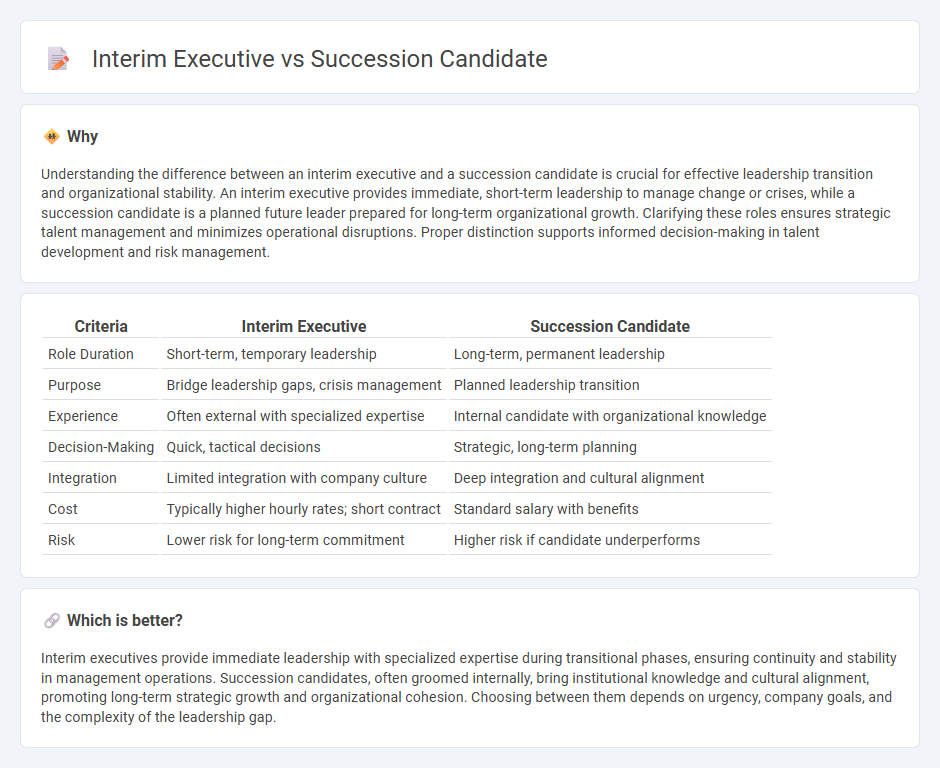
Interim executives provide immediate leadership during transitional periods, ensuring business continuity with experienced, short-term management solutions. Succession candidates are strategically developed internal leaders prepared to assume long-term responsibilities, aligning with the company's future vision and culture. Explore the key differences and advantages of each approach to optimize leadership strategy.
Why it is important
Understanding the difference between an interim executive and a succession candidate is crucial for effective leadership transition and organizational stability. An interim executive provides immediate, short-term leadership to manage change or crises, while a succession candidate is a planned future leader prepared for long-term organizational growth. Clarifying these roles ensures strategic talent management and minimizes operational disruptions. Proper distinction supports informed decision-making in talent development and risk management.
Comparison Table
| Criteria | Interim Executive | Succession Candidate |
|---|---|---|
| Role Duration | Short-term, temporary leadership | Long-term, permanent leadership |
| Purpose | Bridge leadership gaps, crisis management | Planned leadership transition |
| Experience | Often external with specialized expertise | Internal candidate with organizational knowledge |
| Decision-Making | Quick, tactical decisions | Strategic, long-term planning |
| Integration | Limited integration with company culture | Deep integration and cultural alignment |
| Cost | Typically higher hourly rates; short contract | Standard salary with benefits |
| Risk | Lower risk for long-term commitment | Higher risk if candidate underperforms |
Which is better?
Interim executives provide immediate leadership with specialized expertise during transitional phases, ensuring continuity and stability in management operations. Succession candidates, often groomed internally, bring institutional knowledge and cultural alignment, promoting long-term strategic growth and organizational cohesion. Choosing between them depends on urgency, company goals, and the complexity of the leadership gap.
Connection
Interim executives serve as temporary leaders who maintain stability and drive strategic initiatives during transitional periods in an organization. Succession candidates are identified and developed to permanently fill key leadership roles, ensuring continuity and long-term organizational success. The interim executive period allows for effective evaluation and preparation of succession candidates, aligning leadership transitions with business objectives.
Key Terms
Leadership Continuity
Succession candidates are strategically identified future leaders groomed to seamlessly assume key roles, ensuring leadership continuity during planned transitions. Interim executives provide immediate, temporary leadership to maintain operations and stabilize the organization during unexpected vacancies or crises. Explore how integrating both approaches can optimize leadership continuity in your organization.
Talent Pipeline
Succession candidates are internal talents groomed to assume leadership roles, ensuring continuity and stability within the organization's talent pipeline. Interim executives are external or internal professionals appointed temporarily to fill leadership gaps, providing immediate expertise without long-term commitment. Explore effective strategies to balance succession planning and interim appointments for a resilient talent pipeline.
Transitional Authority
Succession candidates are chosen for permanent leadership roles and undergo extensive preparation to ensure seamless transition, while interim executives assume Transitional Authority during unexpected vacancies or organizational changes, providing immediate leadership without long-term commitment. Transitional Authority involves the temporary power to make critical decisions and maintain operational stability, ensuring continuity until a permanent leader is appointed. Discover how effective Transitional Authority shapes organizational resilience and leadership succession.
Source and External Links
Succession Planning: A Step-by-Step Guide - This guide outlines the process of identifying and developing succession candidates based on performance, organizational fit, and leadership potential.
Succession: Internal or External for Critical Transitions - This article discusses the importance of succession planning in identifying and developing internal candidates for critical roles to ensure business continuity.
Succession Planning: All You Need To Know - This comprehensive guide to succession planning covers creating a succession matrix and managing turnover to ensure that critical roles are filled with qualified candidates.
 dowidth.com
dowidth.com